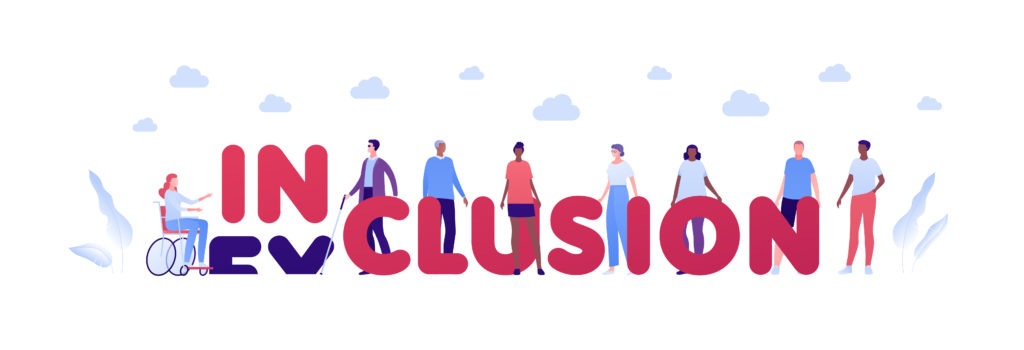Written by Bianca Baldo
Part 2 – Landscape and consequences, exploring Ableism in employment.
Using an intersectional perspective to explore diversity in disability
The UN Convention on Rights of Persons with Disabilities defines a person with a disability as having “long-term physical, mental, intellectual or sensory impairments which in interaction with various barriers may hinder full and effective participation in society.” Importantly, this definition incorporates numerous types of conditions and emphasizes the diversity in disability that limits and acts as barriers to participation. From a GBA+ perspective, we want to look at the various ways identity factors influence a disability.
For example, a library without accessibility ramps to enter can directly impact a person’s participation with a physical disability. Most people can see how the lack of adapted services impacts community members. The woman in a wheelchair, an older man with a cane, a young boy with walking aids, and a mother with a stroller have reduced participation. They are each experiencing barriers that hinder their participation for different reasons, including disabilities.
GBA+ is an analytical tool used to measure how diverse groups of women, men, and non-binary people may experience policies, programs, services, and products differently. In addition to the gender analysis, we must add the different identity factors, such as age, culture, race, disability, ethnicity, class, sexual identity, etc.; we can quickly see the multitude of lived experiences and diversity, inclusion, and equality considerations. Furthermore, a person with a disability can also be negotiating multiple, compounded, and diverse disabilities, each requiring a different set of accommodations and mitigation strategies to support equity in participation. For more information on GBA+, intersectionality, and identity factors, please consult my recent article Gender-Based Analysis Plus (GBA+): Helping facilitate successful meetings.
The GBA+ analysis pushes the reflection further: the limitation on participation cannot be reduced to only what we can see. For example, people with sensory barriers or anxiety (ex: children with autism) should be accommodated in the library, for instance, providing rooms that are best suited for their needs. For those with other disabilities such as emotional distress, chronic pain who cannot travel to the library should have access to services such as book deliveries. There are countless examples of unseen barriers like these that need to be considered.
All these people have their participation lowered by a disability. Many are still left out of the conversation.

Understanding personal and social Ableism in employment; overcoming bias through a person-first approach.
Ableism is described by the Ontario Human Rights Commission as a “belief system, analogous to racism, sexism or ageism, that sees persons with disabilities as being less worthy of respect and consideration, less able to contribute and participate, or of less inherent value than others. Ableism may be conscious or unconscious and may be embedded in institutions, systems, or society’s broader culture. It can limit the opportunities of persons with disabilities and reduce their inclusion in the life of their communities.”
Ableism exists in all parts of life, impacting a persons’ right to live with dignity, inclusion, equality, equity, and respect. We have seen the devastating impacts of Ableism in history and the mistreatment of persons with disabilities, such as forced institutionalizations and sterilizations and denying access to services, education, and employment. For the scope of this blog, we will focus on employment opportunities and fairly paid work, specifically the ability to secure gainful and meaningful employment without discrimination, prejudice, and exclusion.
Among those aged 25 to 64 years, persons with disabilities were less likely to be employed (59%) than those without disabilities (80%). Persons with more severe disabilities (28%) aged 25 to 64 years were more likely to be living in poverty (as measured by the Market Basket Measure) than their counterparts without disabilities (10%) or with milder disabilities (14%). – Canadian Survey on Disability Reports
Unacceptably, Ableism in employment goes beyond the hiring process. People living with disabilities earn between 70 and 75 percent of the income earned by people without disabilities in most Canadian provinces. Physical, mental, and cultural Ableism is linked to these discrepancies in compensation levels for persons with disabilities. Ableism can be based on physical considerations and referred to attitudes that consider a disability an abnormality rather than an inherent and expected variation in the human condition. Ableism encompasses a wide spectrum of discriminatory acts and behaviors that limits and reduces the person to the ability to participate as equals; a few examples include:
- Physical barriers and lack of accommodation, i.e., a panel is being hosted on a stage that is not accessible to all people or meeting rooms that cannot be accessed by an employee with walking aids or in a wheelchair;
- Microaggression, i.e., jokes or teasing about a disability;
- Physical violation of dignity, i.e., a co-worker beginning to push a co-worker who uses a manual wheelchair down the hall to their office without asking them if they would like help.
To understand Ableism, we must explore the implicit basis around what makes a person have value and challenge negative stereotypes about people with disabilities in every interaction. It is not about being perfect, rather about acknowledging that Ableism is a taught behavior. As such, with a little care, compassion, and social awareness, we can change the way of looking at each of us. We could be part of a society that values differences by adopting a person-first approach supporting the different ways identity factors impact each other. Really, we are all looking for employment that allows us to meet our basic needs while giving us a place where we feel accepted, encouraged, and respected.
Person First puts you, your experiences, wellbeing, needs and feelings at the centre of the caring and support process, and means we seek to understand and have empathy for your daily experience. – Bupa (aged-care)

Promoting a neuro-divergent workplace; shifting towards neuro-pluralism.
The exclusion of persons with disabilities in the workplace can also be connected to neuro-divergence stereotyping. This behavior is linked to discrimination against a person’s mental trait or condition, mental disorder and cognitive impairment, such as autism, learning disorders, ADHD, bipolar, schizophrenia, and personality disorders, specific behavioral phenomena such as stuttering and tics, or intellectual disabilities. In a workplace context, this means that the type of neurological traits promoted in the hiring and retaining of employees and leadership are often limited to one way of thinking and working.
Cultural Ableism, specifically the lack of or misrepresentation of people with diverse abilities in the media, often fosters stereotypes that reduce and promote disabled characters as being frustrated, unapproachable or violent, or other stereotypes that paint them as overly simple, kind, and passive. This is amplified by a generalized lack of education and awareness in schools and mainstream media around disability rights history, culture, and pride movements.
However, it is important to note that we are seeing a shift towards accepting and valuing many different types of minds as a way to encourage new and innovative solutions to old problems, impacting opportunities for employees and leaders with disabilities.
Global companies such as Ernst & Young and Microsoft are looking into employing people typically sidelined because of their mental condition precisely for the benefits that the condition brings. There are encouraging trends around employers showing an increased understanding of the barriers that discourage people with disabilities from applying – i.e., Application format, online accessibility, and even the language of job descriptions. It is encouraging to see job announcements that target people with diverse disabilities to apply for a wide range of positions. Often lacking is how this openness to diversity is implemented in the actual hiring and retention human resource process.
If this article made you want to learn more, please come check out Part 1 & Part 3 of the series.


